All About Absinthe, The Green Fairy
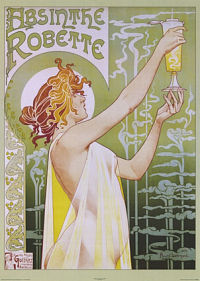 Buy this at AllPosters.com |
Absinthe is known as La Fee Verte or The Green Fairy.
In ancient times, Hippocrates recommended absinthe for jaundice and rheumatism. The first modern usage of Wormwood extract, according to lore, was as an elixir for flatulence in the Middle Ages. Later on (1792 to be precise), Dr. Pierre Ordinaire became the first to extoll the virtues of a commercial brand called Absinthe Suisse. It was in 1797 that Henri-Louis Pernod opened the first of his distilleries, happily enough, producing Absinthe in Switzerland and in France. The Czechs have been making high-quality Absinthe for centuries.
During the 1840’s the French Foriegn Legion was spurred on to combat with liberal doses of Absinthe during the Algerian campaigns, perhaps using it to combat the malaria as well. Absinthe became hugely popular in France about this time. In 1859 Manet painted the Absinthe Drinker, and he met Baudelaire, presumably over a glass of Absinthe. In 1876 Degas painted his famous Absinthe. In 1878 over 7 million liters of the stuff were imported into the puritanical United States!!! Our friend Vincent Van Gogh became one of Absinthe’s first casualties, when he cut off part of his ear, after drinking way too much of the stuff with his friend Paul Gaugin. You can not blame the Absinthe entirely, as Van Gogh was also known to eat his oil paints and drink turpentine, and was known to be psychotic and self-destructive.
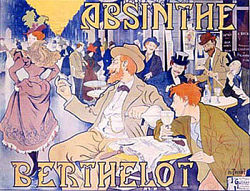 Buy this at AllPosters.com |
Why did Absinthe become so hugely popular at that time? Well, it has been said that Absinthe rose to popularity after a decades long phylloxera blight in the French vineyards. This made wine not only expensive, but very scarce. In those days wine was drunk instead of or mixed with water, as water was loaded with enough bateria to make people sick. So wine was mixed with water, and Absinthe as well, to purify the water.
During the late 1800’s the Green Fairy (absinthe) was being consumed with such glee by the Parisians that the cocktail hour we know as Happy Hour was called L’Heure Verte (The Green Hour). Among the-in crowd then were Oscar Wilde, Ernest Dowson, Pablo Picasso, Arthur Rimbaud, Paul Verlaine, Alistair Crowley, and Charles Baudelaire.
In the early 1900’s the tide turned for the popularity of Absinthe, even though Picasso immortalized it with two pieces – The Absinthe Drinker, and Woman Drinking Absinthe. During the early 1900’s several celebrity murders were attributed to the workings of the Green Fairy, perhaps becasue the thujon content was seven or eight times what is allowed in today’s Absinthe drinks.
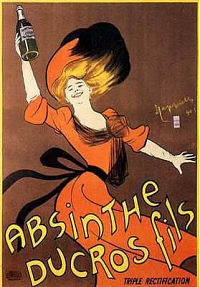 Buy this at AllPosters.com |
In 1901 the Absinthe plant owned and operated by Pernod in Belgium caught fire and blazed for four days before they could put it out. Four years later it was banned in Belgium, and in 1908 it was officially outlawed in Switzerland. The French however, continued their binge until 1915, three years after the United States made it illegal. In 1910 the French made 36 million liters of the stuff for domestic consumption. That is equal to the amount of French Champagne imported to the United States during the year 1986. It was never officially outlawed in Spain, Czech Republic and Britain, so it is now available from many small specialty distilleries.
Artemisia absinthium was used for centuries as a vermifuge and digestive aid. And the active ingredient or essential oil in A. Absinthium is alpha-thujone, which occurs in other things naturally besides wormwood. It is also found in the essential oils of the culinary herbs sage, tansy, and tarragon. In 1990 the scientific community finally recognized that Wormwood extract is as good as chloroqine for the treatment of Malaria.
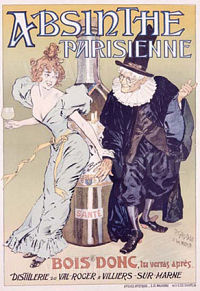 Buy this at AllPosters.com |
Scientifically, the active ingredient in wormwood’s oils, alpha-thujone, has a similar molecular structure to menthol, a-pinene, eucalyptol, camphor and other monoterpenes. Formerly believed to have a THC (cannabinoid) structure-activity relationship and mechanism, a-thujone is now shown to modulate only an entirely different receptor site, the GABA (gamma-aminobutyric acid) system. GABA moderates the firing of neural synapses; a-thujone mildly antagonizes such inhibition. (With thanks to Don Walsh, scientist)
Mr. Walsh also states that: a-Thujone meanwhile is an important component in salves, perfumes, creams, etc. usually as a counter-irritant. The familiar Vicks Vap-O-Rub one’s mother rubs on their chest for relief from a cold contains thujone and other terpenes. So does Absorbine Jr. The anti-insect and preservative properties of white cedar used for clothes chests is due to the thujone in the wood; the classical name for white cedar is Thuja, whence the terpene gets its name. Van Gogh’s doctor sentimentally planted a thuja tree at Vincent’s grave.
Also, vermouth, chartreuse, and benedictine all have small amounts of thujone in them. Vermouth, which is made using Wormwood flowers, takes its name from the german wermuth (wormwood).
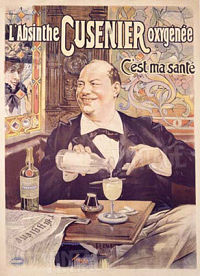 Buy this at AllPosters.com |
And there you have the facts, now the truth is out, and Absinthe is wonderful in moderate quanitites like any other drug. It was commonly served with a special spoon with perforations, that fits over a special glass. The glass would usually hold one fifth Absinthe liquid, with a sugar cube placed on the spoon above it. The French would dribble water (up to four parts water to one part Absinthe) over the sugar, which would melt slowly into the liquid below.
In Prague, center of European culture that it is, Absinthe has been consumed with glee by various thinkers, poets, writers, composers and more. Many places around Prague will serve you a taste of the green Fairy and of course it is readily available for sale just about everywhere.
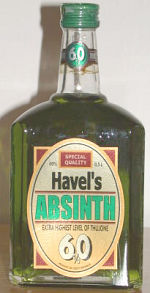 A special thing to do is light the absinthe after pouring it straight over a sugar cube, and then adding a small portion of water to the glass before tossing it down.
A special thing to do is light the absinthe after pouring it straight over a sugar cube, and then adding a small portion of water to the glass before tossing it down.
Absinthe is readily available in the Czech Republic, with several brands worthy of merit. Hill’s, Havel’s, The Green Fairy, Absinthe Original, Absinthe King (with Vincent Van Gogh’s portrait on the label – very pricey) and Absinthe Pilsner Lor are all available for a reasonable price in the Czech Republic. Some brands tout the highest level of thujone allowed. These are usually more expensive.
At this time U.S. Customs is making no efforts to stop the importation of small amounts of Absinthe into the country for personal use. The European Union has issued a standard of purity for the stuff, dictating acceptable levels of thujon and wormwood.
Posted by: skip
Views: 82284
Topic:10